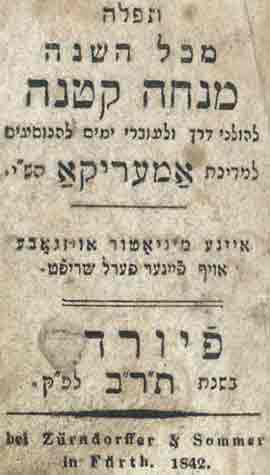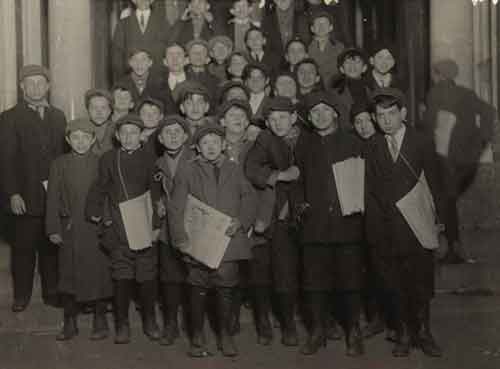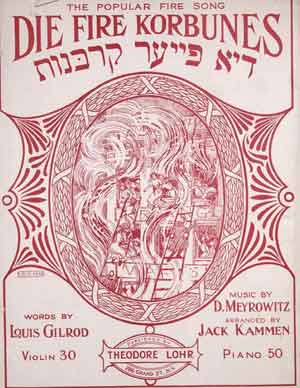From Haven to Home: A Century of Immigration, 1820-1924
In the century spanning the years 1820 through 1924, an increasingly steady flow of Jews made their way to America, culminating in a massive surge of immigrants toward the beginning of the twentieth century. Impelled by economic hardship, persecution, and the great social and political upheavals of the nineteenth century — industrialization, overpopulation, and urbanization — millions of Europe's Jews left their towns and villages and embarked on the arduous journey to the “Golden Land” of America.
In the first half of the nineteenth century, Jewish immigrants came mostly, though not exclusively, from Central Europe. In addition to settling in New York, Philadelphia, and Baltimore, groups of German-speaking Jews made their way to Cincinnati, Albany, Cleveland, Louisville, Minneapolis, St. Louis, New Orleans, San Francisco, and dozens of small towns across the United States. During this period there was an almost hundred-fold increase in America's Jewish population from some 3,000 in 1820 to as many as 300,000 in 1880.
Between 1881 and 1924, the migration shifted from Central Europe eastward, with over two-and- one-half million East European Jews propelled from their native lands by persecution and the lack of economic opportunity. Most of those who arrived as part of this huge influx settled in cities where they clustered in districts close to downtowns, joined the working class, spoke Yiddish, and built strong networks of cultural, spiritual, voluntary, and social organizations. This period of immigration came to an end with the passage of restrictive laws in 1921 and 1924. Jewish emigration from Eastern Europe to the United States never again reached the levels that it did before 1920.
 |  |  | |
This miniature daily prayer book was printed in Germany in 1842, "especially for travelers by sea to the nation of America." It is the first of three editions of this tiny prayer book published between 1840 and 1860 — a period when Jews from German lands immigrated to this country in the tens-of-thousands. Between 1840 and 1860 the Jewish population of this country ballooned from 15,000 to 150,000. Political unrest and economic hardship were primary motivating factors for this migration.Tefilah mi-kol ha-shanah: Minhah Ketanah | Under the Imperial Russian coat of arms, traditionally dressed Russian Jews, packs in hand, line Europe's shore as they gaze across the ocean. Waiting for them under an American eagle holding a banner with the legend "Shelter me in the shadow of your wings" (Psalms 17:8), are their Americanized relatives, whose outstretched arms simultaneously beckon and welcome them to their new home.A Happy New Year. | This World War I poster, published by the United States Food Administration, appeals in Yiddish to the patriotic spirit and gratitude of the new arrivals to America. Its message reads, "Food Will Win the War! You came here seeking freedom, now you must help to preserve it. We must provide the Allies with wheat. Let Nothing Go To Waste!" Versions of this poster were issued in English and Italian as well.Charles Chambers (1883-1941). |
 |
This photograph of newsboys Waiting for the "Forwards," was taken by Lewis Hine at 1:15 a.m. on the steps of the building where the Jewish daily the Forward was produced on New York's Lower East Side. According to Hine, the group included a number of boys as young as ten years-old. The newsboy in the first row is holding copies of Wahrheit [Truth], a Yiddish daily newspaper that stressed Jewish national aspirations.Lewis Hine (1874-1940) |
Jewish women made up the majority of workers in the garment industry, especially in the dress and shirtwaist trade. Poor working conditions, low wages, and frequent layoffs propelled many into the International Ladies' Garment Workers Union. On March 25, 1911, 146 garment workers lost their lives in the Triangle Shirtwaist factory fire in New York's Greenwich Village. Many were trapped inside because the escape exits had been locked to keep the girls in and the union organizers out. The fire was one of New York's worst industrial accidents and was covered by newspapers across the nation, including the Oklahoma State Capital, which is displayed here.
Bain News Service. |
“148 Perished in Fire,” |
Yiddish American popular song was rooted in Eastern European Jewish minstrelsy, which had long addressed current social, economic, and political themes. "Die Fire Korbunes" [The Fire Victims] is an elegy to the 146 victims, mostly young Jewish and Italian immigrant women, who perished in the March 25, 1911 fire at the Triangle Shirtwaist Company factory, a New York City garment sweatshop. David Meyrowitz (1867-1943) and |
A salivating demonic figure, labeled the Triangle Waist Company, draws a long line of women into his factory. There they are consumed by the fire's raging inferno and drift upward towards heaven in the smoky aftermath of the fire. Public sympathy and outrage over the tragedy led to the establishment of a Factory Investigating Commission that was instrumental in drafting new legislation that mandated improved working conditions. Lola [Leon Israel]. |
 |
Albert Potter (1903-1937)
Eastside New York,
between 1931 and 1935
Woodcut print
Ben and Beatrice Goldstein
Foundation Collection
Prints and Photographs Division
Sources: Library of Congress






